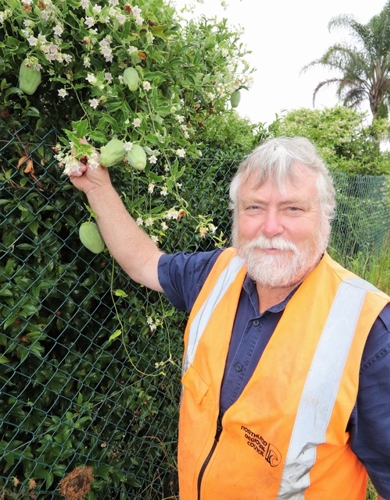Time to tackle moth plant; NRC
27 Jan 2022, 8:07 AM
People are being urged to tackle perennial invasive moth plant as soon as possible before its kapok-like seed pods mature, then burst and infest new areas.
Jack Craw, who chairs the Northland Regional Council’s Biosecurity and Biodiversity Working Party, says the plant – which is native to South America – is an issue because it’s a tough, fast-growing vine that can rapidly climb and smother native and exotic trees.
 Biosecurity officer Doug Foster with a healthy roadside moth plant laden with immature seed pods in the Kerikeri area.“It grows equally well creeping over the ground, shading out low vegetation such as regenerating seedlings.”
Biosecurity officer Doug Foster with a healthy roadside moth plant laden with immature seed pods in the Kerikeri area.“It grows equally well creeping over the ground, shading out low vegetation such as regenerating seedlings.”
Councillor Craw says moth plant is one of Northland’s worst weeds and as well as a common pest along roadsides, forest edges and coastal sites, it’s also a problem in urban reserves and gardens where it can grow up to 10 metres tall.
The plant has easy to see prolific white flowers in January about 25mm across that turn into large hanging kapok-type pods, each of which splits open to release hundreds of seeds with silky threads that are carried by the wind to new sites.
“At this time of the year moth plant vines are often heavy with flower and immature seed pods and its best to tackle the plant now as it is easy to see, before those pods can ripen and burst over the next few months. If pulled or dug out before the pods mature it is not necessary to remove the vine or pods from the tree it’s climbing up.”
Councillor Craw says the seeds are poisonous to humans, and the pods and stems also contain a milky sap which is a skin irritant, making gloves a recommended option when handling moth plant.
“Options to control moth plant including spraying or removing them by hand and collection of mature seed pods, the latter which unfortunately can be quite labour-intensive.”
Councillor Craw says if caught early enough, small moth plant seedlings can simply be pulled out. However, the roots of large plants should be cut out at least five centimetres underground or herbicide used to control the plant.
“Cut down and stump-treat larger stems with 200mls Banvine® per 1 litre water or 100mls Brushkiller per 1 litre water or Metgel. Clear off desirable trees and spray carefully with 120mls Banvine® per 10 litres water or 120mls Brushkiller per 10 litres water or 5g metsulfuron-methyl (600 g/kg e.g. Escort®) + 10mls penetrant per 10 litres water.
Spraying of pods with this product appears to kill seeds as well.
Councillor Craw says people keen to know more about how to control moth plant and other pest plants and animals can visit www.nrc.govt.nz/pestcontrolhub
